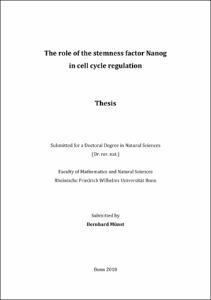The role of the stemness factor Nanog in cell cycle regulation

The role of the stemness factor Nanog in cell cycle regulation

| dc.contributor.advisor | Brüstle, Oliver | |
| dc.contributor.author | Münst, Bernhard | |
| dc.date.accessioned | 2020-04-16T18:03:59Z | |
| dc.date.available | 2020-04-16T18:03:59Z | |
| dc.date.issued | 12.01.2011 | |
| dc.identifier.uri | https://hdl.handle.net/20.500.11811/4906 | |
| dc.description.abstract | Pluripotency of embryonic stem (ES) cells is maintained through various extrinsic and intrinsic influences. In the center of intrinsic stemness signaling, a triad of transcription factors, namely Nanog, Oct3/4 and Sox2, sustain ES cell properties. Among these, Nanog is a particular factor since it mediates acquisition of pluripotency, however, the molecular mechanism underlying stemness function remains unclear. In order to analyze the role of Nanog, a non-genetic gain-of-function paradigm was applied by employing direct protein delivery of Nanog into cells (protein transduction). The biological activity of cell-permeant recombinant Nanog protein, in the following called Nanog-TAT, was assessed using immunofluorescence techniques as well as EMSA demonstrating cellular uptake as well as binding to a specific consensus sequence. A control protein lacking the homeodomain of Nanog (ΔNanog-TAT) showed no binding to the specific consensus sequence. Nanog protein transduction specifically results in an enhanced pluripotent phenotype since the transducible stemness factor liberates murine ES cells from LIF dependence, a phenotype known from genetic overexpression of Nanog in murine ES cells. As it has been shown previously, upon incubation of NIH 3T3 cells with Nanog-TAT, those cells lose contact inhibition and primary mouse embryonic fibroblasts (MEFs) exhibited enhanced proliferation, thereby seeming to bypass senescence. Comprehensive analysis of cell cycle factors revealed that these phenotypic characteristics could be linked to an influence of Nanog-TAT on the cyclin dependent kinase inhibitor (CKI) p27KIP1. Nanog-TAT delivery diminished the expression of p27KIP1 in somatic cells. Western Blot analysis confirmed the mRNA expression analysis. Repression of CKI p27KIP1 subsequently led to the hyperphosphorylation of the tumor suppressor retinoblastoma protein (pRb) thus shifting the protein into its inactive state. These results indicate that MEFs are able to pass beyond the restriction point in cell cycle control otherwise guarded by pRb. A phenotype similar to Nanog-TAT-treated MEFs could be observed upon cultivation of human dermal fibroblasts with Nanog-TAT as those cells exhibit enhanced proliferation rates and additionally do not show senescence-associated β-Galactosidase activity, a marker associated with senescence. Whole genome expression analysis revealed that MP-AF cells cultivated with Nanog-TAT show partially inverted modulation of gene expression compared to senescent human fibroblasts. At later stages during the process of cellular reprogramming, Nanog protein transduction enhanced the efficiency of induction of pluripotency analyzed by re-activation of the Oct3/4 promoter region 3-fold. The thereby established induced pluripotent stem (iPS) cells, generated by retroviral transduction with Oct3/4, Klf4, Sox2 and c-myc (OKSM) and the application of Nanog-TAT from day 10 onwards, did not differ from iPS cells established by retroviral transduction of OKSM alone as judged by the expression of alkaline phosphatase (AP), SSEA-1 and Oct3/4 and their differentiation potential in vitro. Thus, Nanog protein transduction is able to conditionally manipulate the stemness status of cells and provides an experimental basis for the molecular analysis of pluripotency maintenance and induction. | en |
| dc.language.iso | eng | |
| dc.rights | In Copyright | |
| dc.rights.uri | http://rightsstatements.org/vocab/InC/1.0/ | |
| dc.subject | Nanog | |
| dc.subject | protein transduction | |
| dc.subject | cell cycle | |
| dc.subject.ddc | 570 Biowissenschaften, Biologie | |
| dc.title | The role of the stemness factor Nanog in cell cycle regulation | |
| dc.type | Dissertation oder Habilitation | |
| dc.publisher.name | Universitäts- und Landesbibliothek Bonn | |
| dc.publisher.location | Bonn | |
| dc.rights.accessRights | openAccess | |
| dc.identifier.urn | https://nbn-resolving.org/urn:nbn:de:hbz:5N-23952 | |
| ulbbn.pubtype | Erstveröffentlichung | |
| ulbbnediss.affiliation.name | Rheinische Friedrich-Wilhelms-Universität Bonn | |
| ulbbnediss.affiliation.location | Bonn | |
| ulbbnediss.thesis.level | Dissertation | |
| ulbbnediss.dissID | 2395 | |
| ulbbnediss.date.accepted | 22.12.2010 | |
| ulbbnediss.fakultaet | Mathematisch-Naturwissenschaftliche Fakultät | |
| dc.contributor.coReferee | Schorle, Hubert |
Files in this item
This item appears in the following Collection(s)
-
E-Dissertationen (4398)




